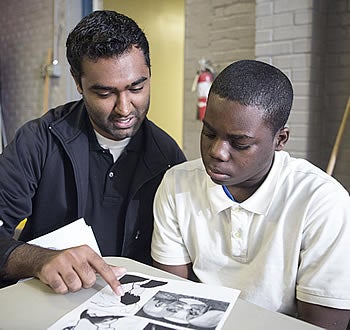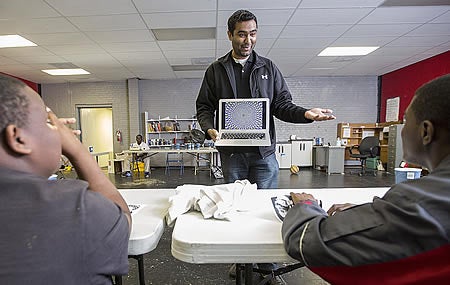In art, lessons for life
GREENVILLE, N.C. (Mar. 12, 2013) — On a recent Friday afternoon at the Building Hope Community Life Center near downtown Greenville, approximately 10 middle and high school boys focused their attention on an optical illusion.
For the adolescent boys, the squinting was worth the effort: The illusion morphed into a color portrait of superstar Beyonce Knowles.

Parteek Singla, left, points out image details to Jalen Staton at the Buildig Hope Community Center. Photos by Cliff Hollis
The activity was part of Brody School of Medicine student Parteek Singla’s Project JUMPST(ART), in which he uses art to teach the youth about health and healthful lifestyles. Singla is one of six East Carolina University medical and dental students who are 2012-13 Schweitzer Fellows. The students commit to a year of service with a community agency, devoting more than 600 hours to local communities lacking access to adequate health services.
“Today was the wrap-up session on our discussion of bullying,” Singla said afterward. “The purpose of the session was to illustrate to students that there are multiple ways of looking at an image. What one person sees may not necessarily be what another person sees. The same concept can be applied to people and how our perceptions of others can change if we took the time to look at them from another perspective.”
The activity also introduced students to optical illusions and helped them appreciate different art mediums.
“It’s really fun,” said Jahtwan Mooring, 11, a sixth-grader at C.M. Eppes Middle School. “He does a good job of showing us arts and crafts and getting us to do hand-on activities” while also teaching about health topics.
The Schweitzer Fellows program conducted a Q-and-A with Singla about his project. An edited version follows:
Q: Why did you decide to develop your particular project?
Singla: My past service projects have focused on young people because I strongly believe in the importance of educating youth to create a strong foundation for the future. If you ask most young people today for a list of their role models, you will hear about pop artists, fashion models, actors and sports athletes. While these individuals have worked hard to be successful, it is ironic that young people often choose role models whom they barely know. And with the media focusing on the faults of many of these role models, it is no wonder that young people can get confused about the meaning of success. Education can empower young people to make responsible, informed decisions.
The art aspect of my project stemmed from my parents doing art activities with me as a kid. I was really shy growing up, and art was an avenue for me to express myself in a way that I couldn’t do with words. Even to this day, I enjoy photography, which allows me to view the world through a different set of lenses. My project combines my dual interests in health and art and sees students learning about health topics by using art as a therapeutic medium.
Q: What do you hope will be the lasting impact of your project on the community it serves?
Singla: I hope that with a better understanding of health topics, students will make educated decisions that can reduce their health risks in the future. As a prospective physician, I think it is important to address youth education early to identify risk factors that can otherwise lead to chronic health problems. By using art as a medium for health education, I hope that students will think about how they deal with challenges and encourage them to venture out of their comfort zones to try something new. At the end of each semester, the project will culminate in a public gallery exhibit where parents will have the opportunity to visit the community center and see the art that the students have produced. Issues such as drinking, drug use and sex are often uncomfortable issues for students to discuss with their parents. However, I hope that as students become more knowledgeable, they become more empowered to ask questions that let their parents know of the issues in their lives. Rather than assuming that their kids are too young to understand, parents can use this project as a foundation to talk to their kids about the issues and be a role model by example. Given the potential lasting impact on the community, I have involved students at the local university and plan to train them to conduct activities beyond the fellowship year for sustainability.
Q: What do you think is the most pressing health-related issue of our time, and how do you think it should be addressed?
Singla: There is no doubt that chronic diseases are important health-related issues of our time. Lifestyle risk factors that begin early in youth continue and build up to cause significant health risks later in life. Youth education is the best approach to reducing the incidences of chronic diseases. If more focus can be placed on youth education about chronic diseases and risk factors, then individuals can adopt healthy behaviors early in life that will hopefully prevent them from having to deal with these issues in the future.
Q: What has been the most surprising element of your experience as a Schweitzer Fellow so far?
Singla: What has been most surprising is the high level of interest the students already have in art. The group has already been involved in painting a mural and has worked together to build a metal sculpture that is on display. Students have talked with me about their favorite types of art, and some have brought their previous artwork to show the group. There are a lot of budding artists with enormous creativity within the group and it is rewarding to see how art has helped serve as an outlet for them to express their interests much in the same way art has helped me.
Q: What does being a Schweitzer Fellow mean to you?
Singla: Being a Schweitzer Fellow means being a part of a group working to make positive national change. I enjoy learning and working with other fellows and using their projects as a way to learn more about the issues in today’s society. I hope that by working with the other fellows, our work can be the pebble that creates a ripple effect to encourage others in the community to get out and give back. Though “Fellows for Life” may be for Schweitzer Fellows, I see the group as a collective of all individuals everywhere working to make positive change in their communities. As Albert Schweitzer once stated, “Do something wonderful, people may imitate it.” In the same way, “Fellows for Life” are individuals who are constantly leading by example and motivating others everywhere to get out and make a difference.
More information about the Schweitzer Fellowship program is available at http://www.schweitzerfellowship.org.
- Singla describes an optical illusion to students at the Building Hope Community Center.
- With this image, stare at the red dot for 30 seconds and then immediately look at a blank, white piece of paper, blink repeatedly, and watch as a color image of singer Beyonce Knowles appears. Image courtesy Parteek Singla

